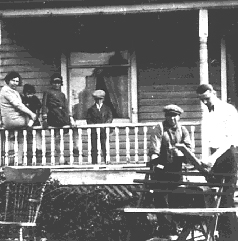![[Industrial Trail Logo]](logosmall.jpg) MADE
IN HAMILTON
MADE
IN HAMILTON20TH CENTURY
INDUSTRIAL TRAIL
![[Industrial Trail Logo]](logosmall.jpg) MADE
IN HAMILTON
MADE
IN HAMILTON
20TH CENTURY
INDUSTRIAL TRAIL
SITE
19
WORKERS'
SUBURBS
UNION PARK, c. 1900
 South
of Barton Street between Kenilworth Avenue and Ottawa Street lies one of the
many workers' neighbourhoods that took shape as industry moved east. Union Park
was on the extreme eastern fringe of the city when it was purchased, named and
subdivided in 1900. Some early east end neighbourhoods were developed by local
factory-owners, eager to recruit a dependable workforce. Others - like Union
Park-were developed by real estate speculators.
South
of Barton Street between Kenilworth Avenue and Ottawa Street lies one of the
many workers' neighbourhoods that took shape as industry moved east. Union Park
was on the extreme eastern fringe of the city when it was purchased, named and
subdivided in 1900. Some early east end neighbourhoods were developed by local
factory-owners, eager to recruit a dependable workforce. Others - like Union
Park-were developed by real estate speculators.
Union Park mimicked the many middle class suburbs built at this time. It boasted elements of the then-popular City Beautiful Movement, such as a central green boulevard. Yet this was a distinctly working class neighbourhood. Its location on the edge of the city meant land was affordable. Mortgages were often obtained privately. Many of the families that settled here derived an income from one of the city's new east end factories. Their modest wages meant modest homes. These were usually frame structures of 1 to 1 ½ storeys. Homes were often owner-built, finished piece-by-piece as money allowed.
"My brother, dad and I built my house, then
we built my brother's house. I got the wiring from my boss at Hoover. He got
me the heaviest gauge wire you could get - at their prices. He got me the cement
too. I put in the best of everything, but I got most of it through the company.
And when I die I've asked them to bury me there. Because for one little while
that was my part of the world. I owned something, you know, that was me."
Fred Purser, Hoover retiree.